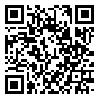1. رفرنس های متنی مثل خروجی کراس رف را در اینجا وارد کرده و تایید کنیداسماعیلی. (1399). بررسی تأثیر رشد اقتصادی و مخارج دولت بر نرخ تورم با استفاده از رویکرد رگرسیون انتقال ملایم (STR). پژوهشهای رشد و توسعه اقتصادی، 12 (45)، 115-130.
2. حامی مهیار (1393). تورم و باز بودن تجارت در ایران: یک تحلیل تجربی (۱۳۸۶-۱۳۴۴). مجله اقتصادي (دوماهنامه بررسي مسائل و سياستهاي اقتصادي). ۱۴ (۵ و ۶)، ۷۷-۸۴.
3. خندانی، محمد (1402). تاثیر سیاست های مالی در تورم. پنجمین کنفرانس ملی و دومین کنفرانس بینالمللی الگوهای نوین مدیریت کسب و کار در شرایط ناپایدار،تهران،https://civilica.com/doc/1780299
4. علی زاده کلاگر، سید قربان، اثنی عشری امیری، پورقربان، احسان فر (1402). اثر حجم نقدینگی بر تورم در ایران با رویکرد مدل پارامتر زمان متغیر. فصلنامه علمی پژوهشی اقتصاد مقداری، 20 (4)، 87-110.
5. فتاحی، شهرام، مرادی، محمد و عباسپور، سحر (1391). تأثیر باز بودن اقتصاد بر تورم با استفاده از رگرسیون چندکی. فصلنامه تحقیقات توسعه اقتصادی، 2(6)، 81-108.
6. مهرآرا، محسن، برخورداری، سجاد، و بهزادی صوفیانی، محسن (1394). تاثیر مخارج دولت بر تورم در عبور از محیط تورمی با رویکرد STR. فصلنامه تحقیقات اقتصادی، 16 (60)، 75-105.
7. نصیری زاده، حمیدرضا و نونژاد، مسعود و ابراهیمی میمند، عصمت (1391). باز بودن تجاری، مبادله تولید- تورم و تورم در کشورهای منتخب عضو سازمان کنفرانس اسلامی، https://civilica.com/doc/1935644.
8. References
9. Alizadeh Kalagar, S.Q., Ezniashri-Amiri, A., Pourghorban, M.R. & Ehsanfar, M.H. (2024). The Effect of Liquidity Volume on Inflation in Iran with Time varying Parameter Model Approach. Quarterly Journal of Quantitative Economics, 20 (4), 87-110. [
DOI:10.22055/jqe.2021.35882.2297 (in Persian).]
10. Ang, J. B. (2007). CO2 emissions, energy consumption, and output in France. Energy Policy, 35(10), 4772-4778. [
DOI:10.1016/j.enpol.2007.03.032]
11. Anzoategu, D., Comin M., Gertler D. & J. Martinez (2019). Endogenous technology adoption and R & D as sources of business cycle persistence. American Economic Journal: Macroeconomics, 11, 67-110. [
DOI:10.1257/mac.20170269]
12. Babatunde M.A. (2017). Trade Openness and Inflation in Nigeria: A Nonlinear ARDL Analysis. Journal of Economics and Sustainable Development, 8 (24), 129-148.
13. Balassa,B. (1964). The Purchasing Power Parity Doctrine: A Reappraisal. Journal of Political Economy, 72,584-596. [
DOI:10.1086/258965]
14. Barro, R. & Gordon, D. (1983). A Positive Theory of Monetary Policy in a Natural Rate Model. Journal of Political Economy, 91: 589-610. [
DOI:10.1086/261167]
15. Bianchi F., Kung H. & Morales, G. (2019). Growth, slowdowns, and recoveries. Journal of Monetary Economics, 101,47-63. [
DOI:10.1016/j.jmoneco.2018.07.001]
16. Bowdler C. & Nunziata, L. (2010). Labor Market Structures and the Sacrifice Ratio. Journal of Macroeconomics, 32(3), 816-826. [
DOI:10.1016/j.jmacro.2010.01.003]
17. Bowdler C. (2009). Openness, Exchange Rate Regimes, and the Phillips Curve. Journal of International Money and Finance, 28(1),148-160. [
DOI:10.1016/j.jimonfin.2008.08.002]
18. Caporale, B. & Caporale, T. (2008). Political Regimes and the Cost of Disinflation. Journal of Money, Credit and Banking, 40(7), 1541-1554. [
DOI:10.1111/j.1538-4616.2008.00172.x]
19. Cassel, K. G. (1922). Money and Foreign Exchange after 1914.
20. Cavelaars P. (2009). Does Globalization Discipline Monetary Policymakers?. Journal of International Money and Finance, 28(3): 392-405. [
DOI:10.1016/j.jimonfin.2008.08.017]
21. Cooke, D. (2004). Openness and Inflation. http://fmwww.bc.edu/repec/mmfc04/99.pdf.
22. Daniels, J & VanHoose, D. (2006). Openness, the Sacrifice Ratio, and Inflation: is there a Puzzle?. Journal of International Money and Finance, 25 (8),1336-1347. [
DOI:10.1016/j.jimonfin.2006.09.005]
23. Daniels, J. & VanHoose, D. (2009). Trade Openness, Capital Mobility, and the Sacrifice Ratio. Open Economies Review, 20(4), 473-487. [
DOI:10.1007/s11079-008-9093-5]
24. Daniels, J. & VanHoose, D. (2013). Exchange-rate Pass Through, Openness, and the Sacrifice Ratio. Journal of International Money and Finance, 36(1),131-150. [
DOI:10.1016/j.jimonfin.2013.03.006]
25. Dixit, A. (1989). Hysteresis, import penetration, and exchange rate pass-through. Quarterly Journal of Economics,104, 205-228. [
DOI:10.2307/2937845]
26. Dornbusch, R. (1987). Exchange rates and prices. American Economic Review, 77, 93-106.
27. Esmaeili, B. (2020). Study of the Effect of Economic Growth and Government Spending on Inflation Rate Using the Soft Transition Regression (STR) Approach. Economic Growth and Development Research, 12 (45), 115-130 (in Persian).
28. Fattahi, Sh., Moradi, M. & Abbaspour, S. (2012). The Effect of Economy Openness on Inflation Using Quantile Regression. Economic Development Research Quarterly, 2(6), 81-108 (in Persian).
29. Goldberg, P. & Kentter, M.M. (1997). Goods Prices and Exchange Rates: What Have We Learned?. Journal of Economic Literature, 35, 1243-1272. [
DOI:10.3386/w5862]
30. Haile, M.A. (2017). Does Trade Openness Reduce Inflation? Empirical Evidence from Ethiopia. Global Journal of Management and Business Research, 17 (1), 32-41.
31. Hajilee, M., Stringer Y.D. & Metghalchi, M. (2017). Financial market inclusion, shadow economy and economic growth: new evidence from emerging economies. The Quarterly Review of Economics and Finance, 66, 149-158. [
DOI:10.1016/j.qref.2017.07.015]
32. Hami, M. (2014). Inflation and trade openness in Iran: an empirical analysis (1386-1344). Economic Journal, 14(5 and 6), 77-84 (in Persian).
33. Ijaz Hussain, M. & T. Zafar (2018). The Interrelationship between Money Supp Inflation, Public Expenditure and Economic Growth. European Online Journal of Natural and Social Sciences, 7(1), 1-24.
34. Ji, Y. P. (2009). A study on pass-through effect of RMD exchange rate volatility to domestic prices. The Journal of Guangdong University of Finance, 24(4), 75-86.
35. Jørgensen, P.L. & Ravn, S.H. (2022). The inflation response to government spending shocks: A fiscal price puzzle?. European Economic Review, 141, 103982. [
DOI:10.1016/j.euroecorev.2021.103982]
36. Khandani, M. (2023). The effect of financial policies on inflation. the fifth national conference and the second international conference on new models of business management in unstable conditions, Tehran, https://civilica.com/doc/1780299. (in Persian).
37. Koengkan, M. (2018). The positive influence of urbanization on energy consumption in Latin American countries: an approach with ARDL and NARDL modeling. Revista de Estudos Sociais, 20(40), 4-23. [
DOI:10.19093/res5277]
38. Krugman, P. (1987). Pricing to market when the exchange rate changes. In: Amdt, S., Richardson, D.(Eds.), Real-Financial Linkages among Open Economies,MIT Press, Cambridge,MA.
39. Liu, T.Y. & Ma, J.T. (2024). Exchange rate and inflation between China and the United States: A bootstrap rolling-window approach. Economic Systems, 48(1),101152. [
DOI:10.1016/j.ecosys.2023.101152]
40. Mckinnon, R. I., Chow, G., C.Bai, B. Y., Liao, Z. K., Wang, J. & Wu, X. (2005). Comments of international famous scholars on RMB appreciation. International Economic Review, 6,5-9.
41. Mehr-Ara, M., Barkhordari, S., & Behzadi Soufiani, M. (2015). The Impact of Government Spending on Inflation through the Inflationary Environment; Smooth Transition Regression Approach. Economic Research Quarterly, 16 (60), 105-75 (in Persian).
42. Munir, S. & A.M. Kiani (2011). Relationship between Trade Openness and Inflation: Empirical Evidences from Pakistan (1976-2010). Pakistan Institute of Development Economics, 50(4), 853-876.
43. Nasirizadeh, H., Nonejad, M. & Meimand, E.E. (2012). Trade Openness, the Output-Inflation Tradeoff, and Inflation in Selected Members of OIC Countrie. The Journal of Economic Policy, 4(7), 101-125 (in Persian).
44. Olayungbo, D.O. (2013). Government Spending and Inflation in Nigeria: An Asymmetry Causality Test. International Journal of Humanities and Management Sciences (IJHMS), 1(4), 2320-4044.
45. Pesaran, M. H., Shin Y. & Smith, R. J. (2001). Bounds testing approaches to the analysis of level relationships. Journal of applied econometrics, 16(3), 289-326. [
DOI:10.1002/jae.616]
46. Pickering, A. & Valle, H. (2012). Openness, Imported Commodities, and the Sacrifice Ratio. BE Journal of Macroeconomics (Topics), 12(1),1-26. [
DOI:10.1515/1935-1690.2382]
47. Ramzan, P.D., Fatima, K. & Yousaf, Z. (2013). An Analysis of the relationship between Inflation and Trade Openness. Interdisciplinary Journal of Contemporary Research in Business, 5 (3), 215-229.
48. Rogoff, K. (2003). Globalization and Global Disinflation. Paper presented for Federal Reserve Bank of Kansas, Jackson Hole Conference.
49. Romer, D. (1993). Openness and Inflation: Theory and Evidence. The Quarterly Journal of Economics, 107(4), 869-904. [
DOI:10.2307/2118453]
50. Samuelson, P. (1969). Theoretical Problems on Trade Problems. Review of Economics and Statistics, (46),145-154. [
DOI:10.2307/1928178]
51. Sepehrivand A. & Azizi, J. (2016). The effect of trade openness on inflation in d-8 member countries with an emphasis on Romer theory. Asian Journal of Economic Modelling, 4 (4), 162-167. [
DOI:10.18488/journal.8/2016.4.4/8.4.162.167]
52. Shahzad, U., Orsi, B. & Sharma, G.D. (2024). Managing inflation expectations and the efficiency of monetary policy responses to energy crises. Energy Economics, 133, 107474. [
DOI:10.1016/j.eneco.2024.107474]
53. Shams, A., Khezri M., Gholami, B. & Ayar, Sh. (2018). The Effect of Money Volume Growth on Formation and Stability of Inflation Regimes in Iran Economy. International Journal of Applied Business and Economic Research, (16)3, 765-772.
54. Shin, Y., Yu, B. & Greenwood-Nimmo, M. (2014). Modeling Asymmetric Cointegration and Dynamic Multipliers in a Nonlinear ARDL Framework. Festschrift in Honor of Peter Schmidt, 281-314. [
DOI:10.1007/978-1-4899-8008-3_9]
55. Sikdar A., Kundu N. & Khan Z.S. (2013). Trade openness and inflation: A test of Romer hypothesis for Bangladesh. The Journal of Comilla University, 2 (1), 85-96.
56. Sulehr, F.A. & Khan, J. (2021). The Effect of Trade Openness on Inflation in Pakistan. Bulletin of Business and Economics (BBE), 9(3), 135-140.
57. Ture, H. E. & Khazaei, A.R. (2022). Determinants of Inflation in Iran and Policies to Curb It. International Monetary Fund, 181, 3-32. [
DOI:10.5089/9798400220555.001]
58. World Bank (2020). Price Controls: Good Intentions, Bad Outcomes. Global Economic Prospects: Slow Growth, Policy Challenges, Special Focus 1, January 2020.
59. Wynne, M.A. &. Kersting, E. K (2007). Openness and Inflation". Federal Reserve Bank of Dallas, Staff Papers, No.2.
60. Yiheyis, Z. (2013). Trade Openness and Inflation Performance: A Panel Data Analysis in the Context of African Countries. African Development Review, 25 (1), 67-84. [
DOI:10.1111/j.1467-8268.2013.12014.x]
61. Zakaria, M. (2010). Openness and Inflation: Evidence from Time Series Data. Doğuş Üniversites Dergisi, 11(2), 313-332. [
DOI:10.31671/dogus.2019.171]
62. Zombe, C., Daka, L., Phiri, Ch., Chibwe, F. & Seshaman, V. (2017). Investigating the Causal Relationship between Inflation and Trade Openness using Toda-Yamamoto Approach: Evidence from Zambia. Mediterranean Journal of Social Sciences, 8 (6), 171-182. [
DOI:10.1515/mjss-2017-0054]







